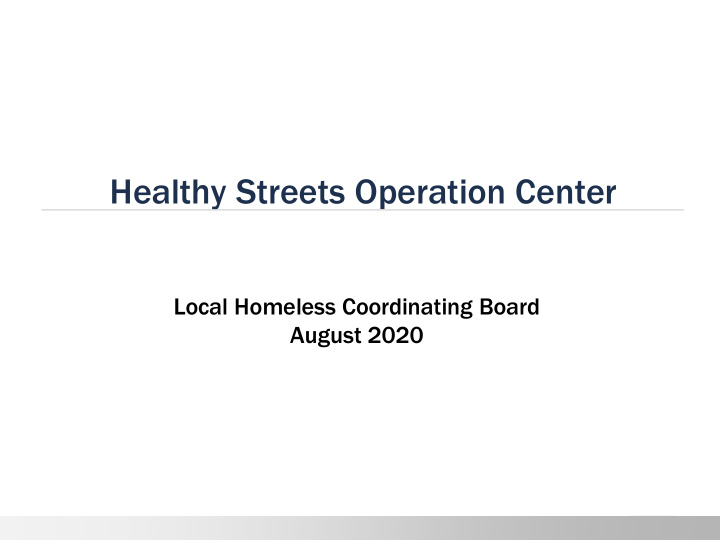



Healthy Streets Operation Center Local Homeless Coordinating Board August 2020
Overv erview iew The Healthy Streets Operations Center (HSOC) launched in January 2018. HSOC uses a unified command structure and a collective impact model to coordinate the efforts of 14 City agencies involved in addressing unsheltered homelessness and behaviors that affect quality of life.
HSOC OC Missio ion & Goals City departments and 1. Reduce the number of community partners, unsheltered individuals and large coordinated through encampments the Health Streets 2. Improve health and safety in Operations Center, will public places, especially in highly work to improve impacted neighborhoods conditions in our public spaces and 3. Advance HSOC operations so the reverse the growth in collaboration can reduce the use of SFPD resources, better unsheltered respond to the pandemic, and homelessness caused by COVID-19. eventually move away from a crisis management approach
COVID ID Comman mand d System tem Operations - Tosan Boyo Support Services Health Services – Human Services – – Christina Jenna Bilinski Doris Barone Andersson Testing Group – Feeding Group – Public Safety Tobi Skotnes Andrea Jorgensen Group Housing Group – Transportation Outbreak Group Irene Augustin Group – Lisa Golden CT/CI Group - Unsheltered Infrastructure Darpun Sachdev Group - Jeff Group & Mivic Hirose Kositsky Medical Group – Andi Tenner & Jonathan Sears 4
HSOC OC: : March – May 2020 • Shelter system was reduced by approximately 75% • CDC recommended against the displacement of encampments • Due to the COVID-19 pandemic, HSOC initially focused on education and outreach • The HSOC Manager was tasked with additional work, including starting the safe sleeping program and neighborhood planning • In April 2019 there were 381 tents and 578 occupied vehicles; in April 2020 there were 1108 and 715 • There were 71 large (6+ tent encampments in May 2020
HSOC OC: : March – May 2020 • The City began standing up new shelters, hotels and safe sleeping sites • HSOC partners, led by the Department of Public Health and advised by the City Attorney, developed Safe Sleeping Guidelines for unsheltered individuals; details can be found at: https://sfdem.org/safe- sleeping-guidance 6
HSOC OC: : June e – Augus ust t 2020 • HSOC began resolving encampments not meeting safe sleeping guidelines by making offers of sleeping alternatives • HSOC made over 700 placements to safe sleeping sites, congregate shelter and hotels from June 10 – August 15 • When safe sleeping alternatives are not available, HSOC does outreach, education and cleaning; HSOC also responds to individual concerns related to COVID-19 • HSOC has resolved 36 large encampments, 22 of which were in the Tenderloin, Civic Center and Lower Polk neighborhoods • HSOC has done over 25 major cleaning and outreach operations, making hotel placements when available
HSOC OC: : June e – Augus ust t 2020 • On July 29 th there were 1003 tents and 804 vehicles • On August 15 th there were 49 large (6+) tent encampments • Other Activities • Developing educational materials • Conducting quarterly tent counts and encampment assessments Planning for the current fiscal year • Improving data collection analysis • • Meeting and corresponding with stakeholders • Collaborating w/neighborhood groups
Budget et Updat ate • Staff that participate in this collaborative effort often have other job duties outside of HSOC; this is particularly true during the pandemic • The Mayor’s Budget Office is currently working on the new City budget and has not been able to conduct an analysis of HSOC expenditures and budget • This information will be provided to the LCHB as soon as possible • Specific questions about staff allocations and budgets can be addressed by department heads during the Q&A portion of this meeting
Questi tions and Answer ers: : Publ blic ic Safety ety 1. Questions submitted by the LCHB a. Do police send information on drug trafficking suspects to ICE? b. How is public drug use being treated going forward? 2. Other Questions from the LCHB 3. Questions from the Public
Questi tions and Answer ers: : Socia ial l Serv rvic ices es 1. Questions submitted by the LCHB a. Are there adequate resources to address the Fentanyl problem b. What percentage of free needles are being picked up and are you addressing the shortfall, time lags? c. How many people are currently employed on the HOT team; are there plans for expansion and are you actively recruiting? d. Are there more vehicle encampment sites being offered/ considered? When will they be available? e. What is the current acceptance rate for services and how might that be improved? Why are there so many “ service resistant “ residents? 2. Other Questions from the LCHB 3. Questions from the Public
Questi tions and Answer ers: : Infras rastr truc ucture ture 1. Questions submitted by the LCHB a. On average, how many weekly 311 calls have been made during COVID with respect to encampment removals and drug sales and use? b. What percentage of 311 calls were successfully addressed by your metric? c. How can HSOC and DPW partner more effectively to clean these sites and engage encampment residents to participate? 2. Other Questions from the LCHB 3. Questions from the Public
Publi lic Comme ment
Recommend
More recommend